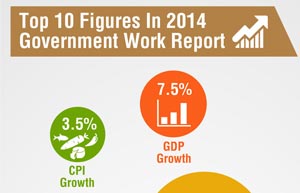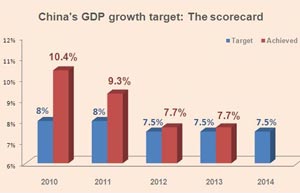Urbanization should be for people's sake
By Xin Zhiming (chinadaily.com.cn) Updated: 2014-03-17 11:20China has released its first-ever national urbanization plan for 2014-2020, the successful implementation of which will have a great bearing on the country's economic vitality in the middle and long term.
According to the National New-Type Urbanization Plan, China's urbanization rate would be raised to about 60 percent by 2020 from the current 53 percent. If that is achieved, it would create enormous investment, consumption and other economic activities brought by the massive transfer of rural people to the urban areas.
No doubt, that process would constitute a dearly-needed driving force for the Chinese economy, which has shown signs of slowdown. Last year, it expanded by a rarely low 7.7 percent year-on-year, the lowest in 14 years.
The slowdown, to a largest extent, is due to the lack of new growth engines for the world's second-largest economy as it has grown at a fast pace for more than 30 years. As policymakers have expected, the urbanization drive will inject fresh vitality into the Chinese economy in the coming decade and in a longer term.
Different from the past, the top leadership has made it clear that the current urbanization drive should be people-oriented; that is, the improvement in the well-being of the people should be top the agenda of the policymakers.
Therefore, the new-type urbanization plan has rightly focused on a balance between economic development and improvement in people's livelihood. For example, the plan requires that pleasant living conditions in the new towns should be ensured by making basic public services accessible to all the new urban settlers and a better ecologic system should be pursued to ensure people can enjoy clean air and safe drinking water.
While the plan has been ambitious to bring change, it must be cautioned that during the implementation of the plan, the local policymakers must not be allowed to go wry and repeat the past growth models that stressed economic growth figures instead of a balance among growth, environmental protection and improvement in people's livelihood.
To that end, the urbanization rate should not be an assessing criterion for the performance of the local officials, so that they can have more room to promote a balanced local development.
Moreover, a more reasonable assessment standards should be devised, in which efforts by the local officials to pursue balanced development should be properly honored.
|
 |
 |
- NHTSA says finds no 'defect trend' in Tesla Model S sedans
- WTO rare earth ruling is unfair
- Amway says 2014 China sales may grow 8%
- President Xi in Europe: Forging deals, boosting business
- CNOOC releases 2013 sustainability report
- Local production by Chery Jaguar Land Rover this year
- Car lovers test their need for speed in BMW Mission 3
- China stocks close mixed Monday

















